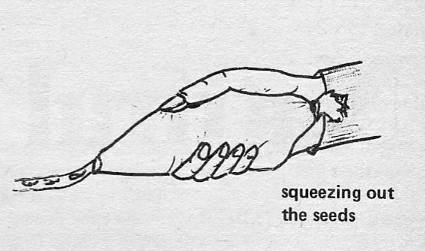Fluid seed sowing is a simple method to help you handle tiny seeds, spacing them further apart and more evenly than you can by hand. It is particularly effective with pre-germinated seeds

Fluid Seed Sowing
Many small seeds, such as carrots, are difficult to handle. When sowing directly outside it is hard to space seeds correctly and a slip of the fingers results in a pinch of seeds being dropped together.
An old but effective method of spacing small seeds is fluid sowing. It is not perfect, but it is a lot easier than hand sowing when sowing outside. Basically the seeds are mixed into a thick liquid, a paste, and then sown by squeezing the seed-containing fluid into the sowing drill using a piping bag.
You can control the density of seeds by how many you mix in per pint of paste and how large the nozzle in the piping bag. If you don’t have a piping bag available, an ordinary plastic bag will do with the corner cut off to squeeze the past through.
Aim to get enough seeds in the mix and the squeezing rate to cover 3 metres of row per 150ml of paste. It can be worth practising with some paste with no seeds in first to get an idea of how thick to make the tube.
Once you’ve sown your row, cover with as much soil as you would for a normal sowing.
Paste Mix for Fluid Sowing
When I first heard of and tried fluid sowing, the recommended medium was a basic cold-water starch wallpaper paste available from any hardware shop. Nowadays this is impossible to obtain as far as I know. Most wallpaper pastes contain fungicides and even those that don’t are sold as specialist ‘green’ products at a surcharge.
Luckily it is easy to make your own fluid sowing medium using cornflour which is easily and cheaply available. Take 100 grams of cornflour (corn starch) and mix to a paste with a little water. Once smooth, add more water up to a litre ensuring there are no lumps. Next, heat gently, stirring continuously until it thickens. Leave to cool and then add your seeds and mix well.
Do check the temperature before adding the seeds – you don’t want to cook them!
If the paste is too thick, just add more water. If the seeds sink in the paste then you need to thicken the jelly with more cornflour. It will keep for at least a few days if you make too much.
Seed Germination with Fluid Sowing
My experience is that germination and establishment rates are improved by fluid sowing. I suspect this is due to the seed being held in the fluid medium and water being available even in dry periods.
Fungicide containing wallpaper pastes can result in very poor to zero germination and I’ve not tried using a sowing medium of modern Methyl cellulose based pastes as it is far cheaper to make it using cornflour. Possibly the cornstarch provides some nutrients for the seedlings which Methyl cellulose would not.
Fluid Sowing of Pre-Germinated (Chitted) Seeds
Often you can find a half packet of seeds that may or may not be viable. This will depend on the age of the seeds, the species and how they’ve been stored. Pre-germinating is the usual and accurate method of gauging percentage viability of seeds. See Seed Storage & Longevity
Once the seeds start to germinate, don’t leave them to produce too long a shoot. For small seeds like lettuce or carrots 5mm maximum or for larger seeds 10mm
Rinse the seeds carefully and very gently from the paper, collect in a sieve and then mix gently in with the paste before sowing.
Pre-germination and fluid sowing is particularly useful for difficult seeds like parsnips and celery and helpful for most small seeds as the germination process takes place in ideal conditions.



